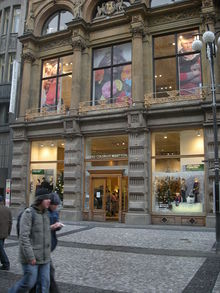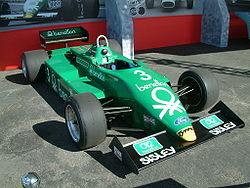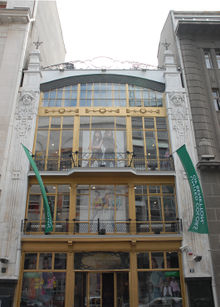Benetton Group
 |
|
| Type | Public (BIT: BEN) |
|---|---|
| Industry | Fashion |
| Founded | 1965 |
| Headquarters | |
| Key people | Luciano Benetton, Chairman Carlo Benetton, Deputy Chairman Alessandro Benetton, Executive Deputy Chairman Franco Furnò and Biagio Chiarolanza, delegating operative management of the company Giuliana Benetton, Director Gilberto Benetton, Director |
| Products | Clothing, Accessories and Footwear |
| Revenue | 2,049 million euro (2009) |
| Employees | 9,511 (2009) |
| Website | www.benettongroup.com |
Benetton Group S.p.A. is a global fashion brand, based in Treviso, Italy. The name comes from the Benetton family who founded the company in 1965. Benetton Group is listed in Milan (BIT: BEN). Benetton has a network of around 6,000 stores in 120 countries. The stores are managed by independent partners and generate a total turnover of over 2 billion euro.[1]
Contents |
Early years
In 1965, Luciano Benetton, the eldest of four children, was a 30-year-old salesman in Treviso. He saw a market for colourful clothes, and sold a younger brother's bicycle in order to buy his first second-hand knitting machine. His initial small collection of sweaters received a positive response in local stores in the Veneto region, and soon after he asked his sister and two younger brothers, Gilberto and Carlo, to join him. In 1965, the entity known as the "Benetton Group" is formed.[2]
In 1966, the Benettons opened their first store in Belluno and three years after in Paris, with Luciano as chairman, his brother Gilberto in charge of administration, their younger brother Carlo running production, and Giuliana as a chief designer.
Brands
The company's core business remains their clothing lines. Casual clothing is marketed as the "United Colors of Benetton"; there are also a fashion-oriented "Sisley" division, "Playlife" leisurewear. Their products include womenswear, menswear, childrenswear and underwear and they have expanded into toiletries, perfumes, and items for the home such as kitchen accessories and baby products.

The Group produces over 150 million garments every year and has a network of around 6,000 contemporary stores around the world.[3]
Production
As well as having over 9,000 employees, Benetton has developed a network of small suppliers who do contracting in the Northern Italian region around Treviso.
Marketing

The company is known for sponsorship of a number of sports, and for the provocative and original "United Colors" publicity campaign. The latter originated when photographer Oliviero Toscani was given carte blanche by the Benetton management. Under Toscani's direction, ads were created that contained striking images unrelated to any actual products being sold by the company.
These graphic, billboard-sized ads included depictions of a variety of shocking subjects, one of which featured a deathbed scene of a man (AIDS activist David Kirby) dying from AIDS[4]. Others included a bloodied, unwashed newborn baby with umbilical cord still attached (which was highly controversial), two horses mating, close-up pictures of tattoos reading "HIV Positive" on the bodies of men and women, a collage consisting of genitals of persons of various races, a priest and nun about to engage in a romantic kiss, pictures of inmates on death row, and a picture of a bloodied t-shirt and pants ridden with bullet holes from a soldier killed in the Bosnian War[5]. The company's logo served as the only text accompanying the images in most of these advertisements.
Sport and Sponsorship
Benetton Group entered Formula One as a sponsor of Tyrrell in 1983, then Alfa Romeo in 1984; this arrangement was extended to both Alfa and Toleman in 1985. Benetton Formula Ltd. was formed at the end of 1985 when the Toleman and Spirit teams were sold to the Benetton family. The team saw its greatest success under Flavio Briatore, who managed the team from 1990 to 1997. Michael Schumacher won his first Drivers' Championships with the team in 1994 and 1995, and the team won their only Constructors' title in 1995. From 1996, the team raced under an Italian licence although it continued to be based, like Toleman, in Oxfordshire in England. The team was bought by Renault for US$120m in 2000 and was rebranded Renault F1.
In 1979, Benetton first sponsored their (then amateur) local rugby team, A.S. Rugby Treviso. Benetton Rugby has since become a major force in Italian rugby, with 11 league titles and supplying many players to the national team.[6]
In 1982, the company bought its local basketball team, Pallacanestro Treviso, now commonly known as Benetton Basket. Their Sisley brand sponsors the local volleyball team, Sisley Volley Treviso.
Criticisms
Benetton has faced criticism from Mapuche organizations, over its purchase of traditional Mapuche lands in Patagonia.[7] The Curiñanco-Nahuelquir family was evicted from their land in 2002 following Benetton's claim to it, but the land was restored in 2007.[8]
See also Benetton's position regarding the Mapuche in Patagonia.[9]
Benetton aroused suspicion when they considered using RFID tracking chips on clothes to monitor inventory. A boycott site alleges the tracking chips "can be read from a distance and used to monitor the people wearing them."[10] Issues of consumer privacy were raised and the plan was shelved.
See also Benetton's position on RFID technology.[11]
PETA launched a boycott campaign against Benetton for buying wool from farmers who practiced mulesing. Benetton has since agreed to buy nonmulesed wool and has further urged the wool industry to adopt the PETA and Australian Wool Growers Association agreement to end mulesing.[12]
See also Benetton's position regarding the controversy on mulesing between the Australian Wool Industry and PETA.[13]
Sales by Brand
Benetton achieved 967 million euro in sales of its brand "United Colors of Benetton Adult", that is 51% of the total sales in 2009. Another 31% of sales have been achieved through sales of the brand "United Colors of Benetton Kid", that is 601 million euro. The third highest percentage of 16%, that is 300 million euro grossed the "Sisley" brand. The "Playlife" brand grossed 37 million euro.[14]
Fabrica
Since 1994, the Benetton Group has financed a communication research centre in Treviso. The centre aims to combine culture with industry and offers young people the opportunity for creative growth and multicultural interchange. The centre accepts young people from around the world, and its base was restored and enlarged by Tadao Ando.
Young artists and designers are invited to the centre and given a one-year study grant together with professional training and resources. Residents work in the areas of design, visual communication, photography, interaction, video, music and publishing under the guidance of experts.
See also
- Benetton family
Notes and references
- ↑ "About Benetton". Benetton Group 2010. http://press.benettongroup.com/ben_en/about/. Retrieved May 05, 2010.
- ↑ Timeline of the Benetton Group Benetton Group Official Webpage
- ↑ "About Benetton". Benetton Group 2010. http://press.benettongroup.com/ben_en/about/. Retrieved May 05, 2010.
- ↑ "The Photo That Brought AIDS Home". http://www.life.com/image/first/in-gallery/45701/the-photo-that-brought-aids-home. Retrieved 2010-07-22.
- ↑ "Benetton-Bosnian Soldier Home". http://press.benettongroup.com/ben_en/about/campaigns/list/bosnian_soldier/?t=print. Retrieved 2010-07-22.
- ↑ "Benetton Rugby - Storia". http://www.benettonrugby.it/105_0/default.ashx. Retrieved 2008-04-07. (Italian)
- ↑ "The Invisible Colours of Benetton - Campaign". http://www.mapuche-nation.org/english/main/benetton/main/info.htm. Retrieved 2008-04-07.
- ↑ "Recovered Mapuche territory in Patagonia: Benetton vs. Mapuche". MAPU Association. http://www.santarosarecuperada.com.ar/english/index.html. Retrieved 2008-04-07.
- ↑ "Benetton’s position regarding the Mapuche in Patagonia". http://press.benettongroup.com/ben_en/about/facts/fact2.
- ↑ "Boycott Benetton". http://www.boycottbenetton.com/. Retrieved 2008-04-07.
- ↑ "Benetton’s position on RFID technology". http://press.benettongroup.com/ben_en/about/facts/fact3.
- ↑ "Campaign ends". PETA Save the Sheep! campaign. http://www.savethesheep.com/f-benettonvictory.asp. Retrieved 2008-04-07.
- ↑ "Benetton’s position regarding the controversy on mulesing between the Australian Wool Industry and PETA". http://press.benettongroup.com/ben_en/about/facts/fact1.
- ↑ "Investor Relations Highlights". Benetton Group. May 05, 2010. http://investors.benettongroup.com/phoenix.zhtml?c=114079&p=irol-reportsHighlights. Retrieved May 05, 2010.
External links
- Benetton news and facts FashionUnited
- www.regimbald.ca/Benetton- unofficial chronicle of Benetton advertising under Oliviero Toscani
Official sites
- United Colors of Benetton
- Sisley
- Playlife
- Undercolors
- Fabrica - The Benetton Group social communication research centre
